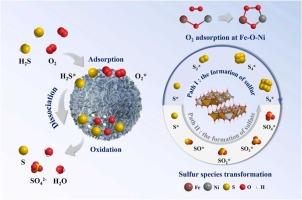Nano-flower spherical NiFe LDH adsorbent for efficient removal of H2S in blast furnace gas
IF 12.2
1区 环境科学与生态学
Q1 ENGINEERING, ENVIRONMENTAL
引用次数: 0
Abstract
Removal of sulfur species from blast furnace gas is urgently needed due to the strict emission limits imposed on iron-steel industrial flue gas. Improving the sulfur capacity of H2S is a crucial challenge to reduce the operation cost. NiFe layered double hydroxide (LDH) adsorbents were synthesized using the hydrothermal method to strengthen the adsorption of H2S, achieving a high sulfur capacity of 133.6 mg/g at 50 °C. Characterization studies have revealed that the reaction pathway of H2S on the NiFe LDH surface involves adsorption, dissociation and oxidation. It has been clarified that the high sulfur capacity can be attributed to the abundant H2S dissociation sites and the excellent O2 activation sites. The dissociation sites of H2S encompass metal sites, -OH and CO32-. The interaction between O2 and the bridge site of asymmetric metal atoms significantly enhances the dissociation of O2. Strengthening the dissociation of H2S and O2 improves the sulfur capacity. The deactivation of adsorbents comes from the continuous consumption of oxygen species mainly composed of -OH and the deposition of sulfur species in the smaller mesopores ranging from 2-10 nm. This work provides useful insights into designing highly efficient iron-based adsorbents for the desulfurization of blast furnace gas.

求助全文
约1分钟内获得全文
求助全文
来源期刊

Journal of Hazardous Materials
工程技术-工程:环境
CiteScore
25.40
自引率
5.90%
发文量
3059
审稿时长
58 days
期刊介绍:
The Journal of Hazardous Materials serves as a global platform for promoting cutting-edge research in the field of Environmental Science and Engineering. Our publication features a wide range of articles, including full-length research papers, review articles, and perspectives, with the aim of enhancing our understanding of the dangers and risks associated with various materials concerning public health and the environment. It is important to note that the term "environmental contaminants" refers specifically to substances that pose hazardous effects through contamination, while excluding those that do not have such impacts on the environment or human health. Moreover, we emphasize the distinction between wastes and hazardous materials in order to provide further clarity on the scope of the journal. We have a keen interest in exploring specific compounds and microbial agents that have adverse effects on the environment.
 求助内容:
求助内容: 应助结果提醒方式:
应助结果提醒方式:


